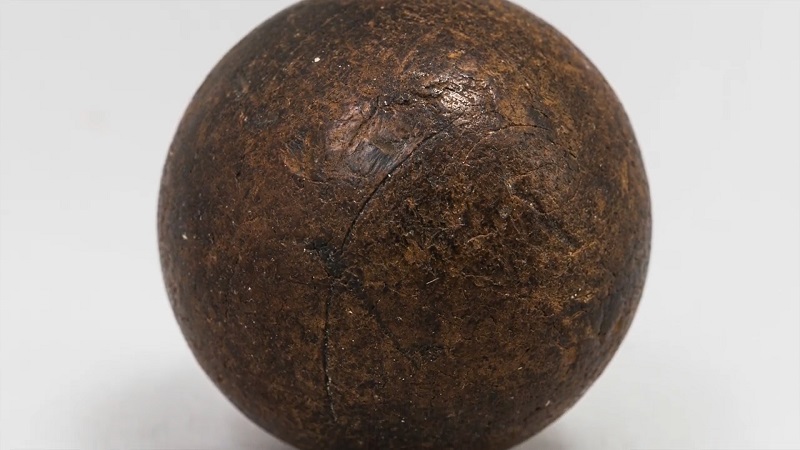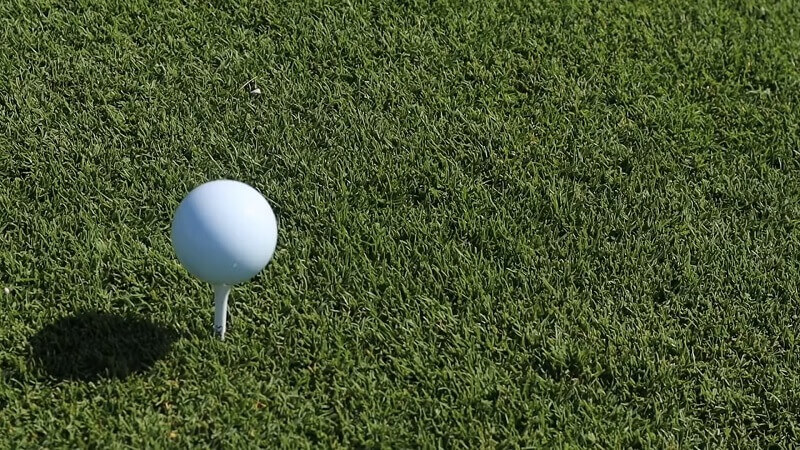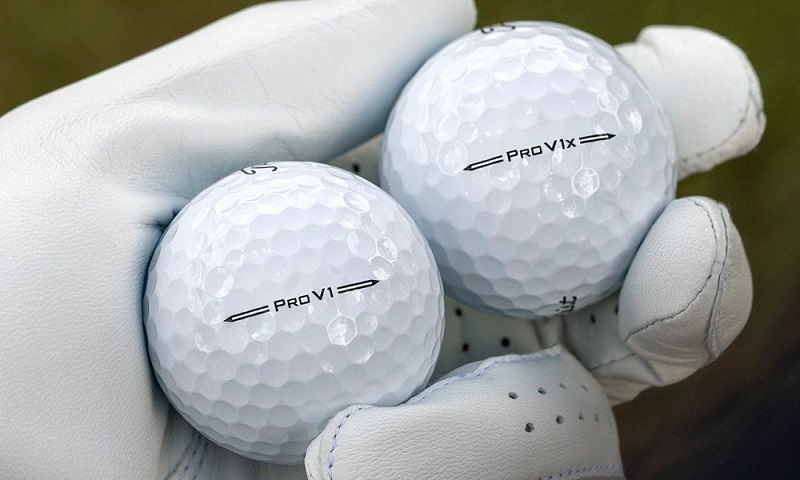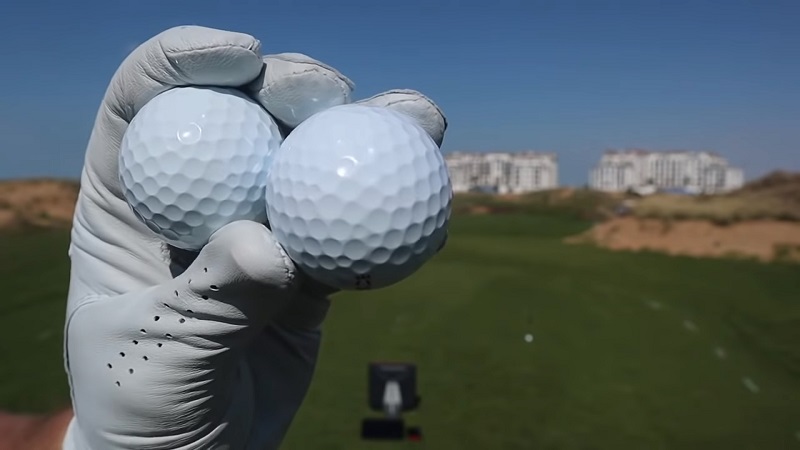Golf balls are dimpled for a reason, not just for looks. Dimples in a golf ball help to keep the ball in the air longer, providing more control and accuracy to professional players. The dimples also affect how far the ball will travel, depending on how many dimples there are and what type of dimple is used.
But why were dimples first introduced? How many dimples are in a golf ball? What is their impact on the ball’s flight path? And what happens to golf balls without dimples? Let’s explore these questions further.
Read more: Who Makes Kirkland Golf Balls?
How Many Dimples Are In A Golf Ball?
The average modern golf ball typically contains between 300 and 500 dimples. However, some brands offer balls with more than 1000 indentations! A record-breaking ball achieved a remarkable feat with 1,070 dimples- 414 larger ones in four varying sizes and 656 minuscule pinhead-sized varieties.
Why Do Golf Balls Have Dimples?
Regarding dimples in golf balls, there are several theories surrounding their purpose. Some contend that dimples help reduce air friction, maintaining ball speed and distance. Others assert that dimples guide amateur players to achieve straighter drives at slower swing speeds.
The most popular theory, however, is that dimples create a ‘screw effect’ which can aid players in attaining further distance and enhanced accuracy when striking the ball.
Whatever the actual reason, one thing is clear; dimples have become an integral part of golf history over decades, transforming golfers’ strivings into great achievements on the green.
History of Dimples On Golf Balls

In 1905, William Taylor – an English engineer and co-founder of the Taylor-Hobson company – revolutionized golf ball manufacturing by patenting a unique dimple design. This pioneering invention provided more control to players as they made their way around the course.
William Taylor noticed that golf players made their balls go further by changing their appearance. He wanted to know what surface made the ball fly the best, so he did tests to find out.
He then made small marks all over the golf ball. He also invented tools to make many golf balls with the same marks. There were other patterns, like “mesh” and “bramble,” but the dimple pattern was better for flying, so it became more popular.
A company made a golf ball with six rows of normal dimples on the equator and shallow dimples everywhere else. This special design made it easier for the ball to adjust its spin when hit. The USGA said this type of ball could not be used in tournaments. The company sued, and the USGA had to pay them $1.375 million, so they would agree not to use this golf ball anymore.
The Technology Used In Dimpled Golf Balls
The dimples on a golf ball are more than meets the eye – they play an important role in determining how the ball moves when hit. But sophisticated technology is needed to achieve dimples of varying size, shape and depth.
Lasers and computer-controlled machines are used to meticulously create dimples around the surface of the golf ball, giving professional players increased accuracy and control with their shots. This precision allows them to make split-second decisions on the angle, spin and trajectory – all factors that could give them an advantage. To ensure this level of accuracy, their dimpled balls must be expertly crafted using advanced technology.
How Do Dimples Affect Ball Flight?
The dimples in a golf ball play an important role in the motion and performance of the ball. Dimples ingeniously minimize air resistance, allowing maximum lift force during flight. By doing so, they not only extend the travel distance of the golf ball but also enhance its stability, allowing for a more reliable and accurate trajectory. This intricate interplay between dimple design, air resistance, and lift is at the core of what makes the sport of golf so fascinating, as even the finest of details can have a profound impact on the game’s outcome. Studying these factors forms the basis for understanding the science at the heart of an effective golf shot.
The number, size, and arrangement of dimples on the ball’s surface significantly influence its aerodynamic performance. An optimal alignment and depth of these dimples can lead to an ideal balance of lift and drag, thereby enhancing the ball’s flight. Interestingly, it has been found that alternating between shallow and deep dimples in the pattern proves to be most beneficial.
Furthermore, maintaining an evenly spaced dimple layout can improve precision, ensuring that shots stay on the desired path rather than veering off course. In essence, the seemingly minute details of golf ball dimples profoundly impact the success and accuracy of a golfer’s performance.
Does A Golf Ball Always Have Dimples?
One of the most prevalent questions centers around the presence of dimples on these little spheres. Contrary to popular belief, golf balls have not always featured dimples.
In fact, the earliest versions of the golf ball were smooth-surfaced, and it wasn’t until golfers realized the advantages of dimples that they became an essential feature of the ball’s design. While golf balls have not always had dimples, they have now become a fundamental and inseparable aspect of modern golf.
What If The Golf Ball Didn’t Have Dimples On It?

At first glance, this is an inconsequential difference. However, the science behind these tiny indentations is integral to the game of golf as we know it.
The dimples enhance the golf ball’s aerodynamics, allowing it to travel far greater distances than it would with a smooth surface. They create turbulence along the ball’s surface, reducing air resistance and enabling a lift force to act upon the golf ball in flight.
Thus, without dimples, the trajectory of a golf ball would be significantly altered, and golfers would be required to adjust their skills and strategies accordingly.
How Do You Know Which Golf Ball Dimple Is Right For You?
Delving into the fascinating world of golf ball dimples reveals an incredible array of variations in both number and size and the unique dimple patterns found across different models and manufacturers.
The dimples on the golf ball play a significant role in shaping these characteristics by affecting the ball’s aerodynamics, ultimately dictating its flight path and behavior.
However, rather than becoming preoccupied with the specific dimple patterns and designs, it is more beneficial for golfers to focus on the overall performance of the ball. By taking note of how the ball behaves in relation to its flight trajectory and the amount of spin it generates, golfers can select the ideal ball to complement their technique and maximize their potential on the course.
After all, expert golf ball designers invest countless hours of research and development into optimizing these factors to achieve the best possible results on the greens. So, trust in their expertise, and let the nuances of dimple patterns become secondary to modern golf balls’ outstanding performance benefits.
Which Famous Golf Balls Brands Have The Most Dimples?

Golf balls with the most dimples usually have dimpled patterns specifically designed for professional players. Professional golf balls typically feature larger dimples, ranging from dimple counts of 400 to 1000 or more. These dimple patterns help enhance accuracy and control over shots, allowing professional players to shape shots better and hit accurate drives over longer distances.
Here are some of the top dimpled golf balls to consider:
– Titleist Pro V1: 392 dimples
– Callaway Chrome Soft: 408 dimples
– Bridgestone Tour B XS: 334 dimples
– TaylorMade TP5: 584 dimples
– Srixon Z-Star XV: 552 dimples.
– Srixon Q Star Tour: 342 dimples.
– Nike RZN Black: 342 dimples.
Read more: Best Golf Balls For Beginners 2023 – Top 10+ Picks & Review
Conclusion
Dimples on a golf ball play an important role in golf. By providing lift and reducing drag, dimpled golf balls enable professional players to shape shots more effectively and accurately. The dimple pattern used also plays a significant role in determining how the ball performs; dimples with intricate patterns are generally preferred by professional players, while dimples with fewer dimples provide more distance confidence for recreational players.
Ultimately, the dimple pattern should be chosen based on individual preferences and playing style. By understanding dimples’ effects on a golf ball and how to choose the right dimple pattern, you can gain an edge over others and improve your overall game performance.
FAQs
What Golf Ball Has 392 Dimples?
The Titleist Pro V1 is one of the dimpled golf balls with the most dimples, featuring an advanced dimple pattern with 392 dimples.
What Dimple Pattern Is Best For Control?
The dimpled golf balls with the most dimples provide greater accuracy and control over shots. Professional dimpled golf balls typically feature dimples in higher numbers, ranging from dimple counts of 400 up to 1000 or more.
How Many Dimples Are On Professional Golf Balls?
Professional golf balls have fewer dimples than recreational or practice ones, harnessing the optimization of aerodynamics and increasing control over the ball. Drivers gain many advantages from dimpled golf balls, as dimples help reduce spin and provide greater distance accuracy during powerful shots.
What Dimple Pattern Is Best For Distance?
Golf balls with fewer dimples tend to provide greater distance confidence. Recreational dimpled golf balls usually feature dimples in lower numbers, ranging from dimple counts of 300 up to 500.
What Dimple Pattern Provides The Most Accuracy?
Golf balls with dimple patterns designed for professional players usually provide the most accuracy, as they can feature dimple counts up to 1000 or more. These dimpled golf balls help enhance accuracy and control over shots, allowing professional players to shape shots and hit more accurate drives.
References: https://en.wikipedia.org/wiki/Golf_ball


